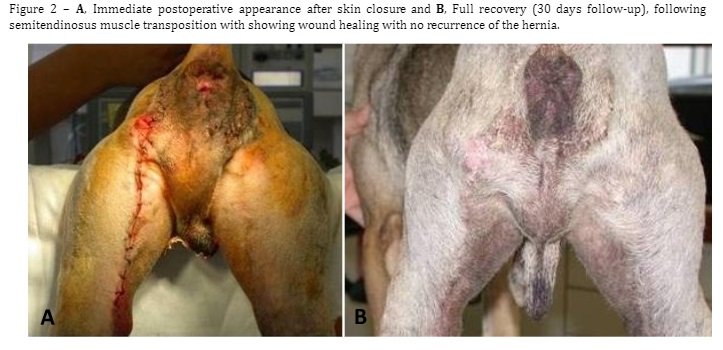Modified semitendinosus muscle transposition to repair bilateral perineal hernias in dogs
DOI:
https://doi.org/10.21708/avb.2024.18.1.11886Resumo
Perineal hernia (PH) resulting from a weakness and tear of the pelvic muscles of the diaphragm. Repair of the pelvic muscles by surgical repositioning is the curative treatment. To report a modified technique of semitendinosus muscle transposition for perineal hernias treatment. Eleven male dogs were prospectively enrolled to repair perineal hernias incorporating contralateral semitendinosus muscle transposition. The transected muscle was rotated medially through the subcutaneous tunnel ventral to the anus up to the opposite lateral perineum. Ten dogs were neutered and 01 was intact. The mean age was 10.45 years and the mean body weight was 18.52 kg. Five dogs had been previously submitted to perineal herniorrhaphy. Partial wound dehiscence occurred in two dogs. Postoperative complications related to the technique were presented in 7 of 11 dogs. Unilateral recurrence was detected in 8 of 11 dogs. The small number of samples, the absence of a control group and the heterogeneity of breeds make it difficult to reach significant conclusions. The transposition of the semitendinosus muscle through the subcutaneous tunnel is feasible to repair perineal hernias. The technique was unable to reduce complications and recurrence rates. However, provides evidence that can be used to repair cases of bilateral and ventral perineal hernias in dogs.
Downloads

Downloads
Publicado
Edição
Seção
Licença
Copyright (c) 2024 Acta Veterinaria Brasilica

Este trabalho está licenciado sob uma licença Creative Commons Attribution 4.0 International License.
Autores que publicam na Acta Veterinaria Brasilica concordam com os seguintes termos: a) Autores mantém os direitos autorais e concedem à revista o direito de primeira publicação, com o trabalho simultaneamente licenciado sob a Licença Creative Commons Attribution que permite o compartilhamento do trabalho com reconhecimento da autoria e publicação inicial nesta revista. b) Autores têm autorização para assumir contratos adicionais separadamente, para distribuição não-exclusiva da versão do trabalho publicada nesta revista (ex.: publicar em repositório institucional ou como capítulo de livro), com reconhecimento de autoria e publicação inicial nesta revista. c) Autores têm permissão e são estimulados a publicar e distribuir seu trabalho online (ex.: em repositórios institucionais ou na sua página pessoal) a qualquer ponto antes ou durante o processo editorial, já que isso pode gerar alterações produtivas, bem como aumentar o impacto e a citação do trabalho publicado (Veja O Efeito do Acesso Livre).


 Esta obra está licenciada com uma Licença
Esta obra está licenciada com uma Licença 